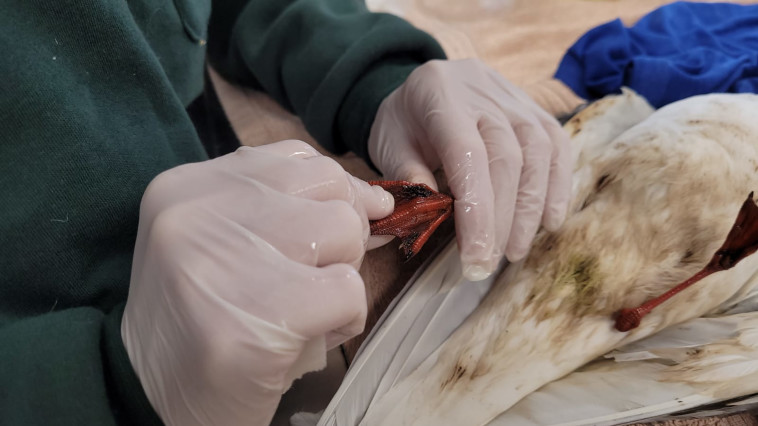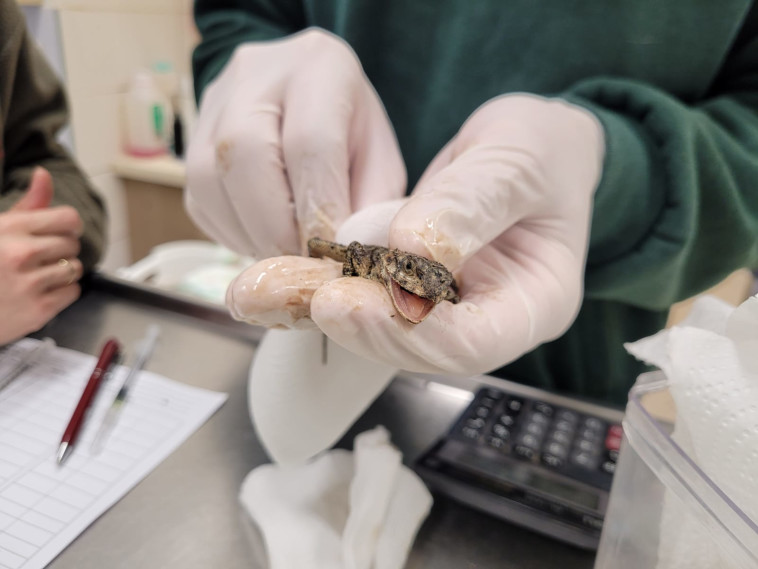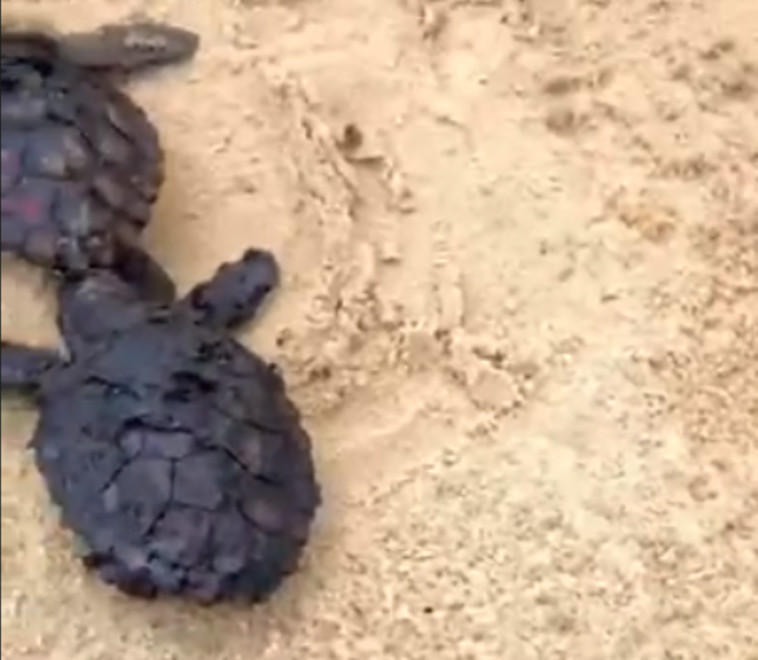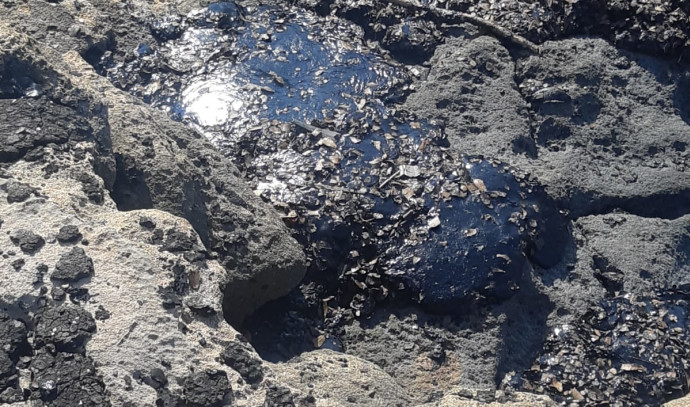The environmental disaster of polluting the shores of the Mediterranean in Israel with tar originating from crude oil spilled into the sea and reached last week under the auspices of the storm most of the coastal strip badly damaged in the disaster, with us to stay in the coming months. The damage is also likely to delay the opening of the upcoming bathing season.
The damage becomes clear as the extent of the destruction to the coastal environment is revealed, and the Ministries of Environmental Protection, Health and the Interior even issued a joint public warning today (Sunday) that bathing, sports and recreational activities should not be reached – until further notice, due to fears that tar exposure could harm public health. The ministries continue to monitor and update the public as needed. “Another patrol flight held by the Ministry of Environmental Protection this morning did not detect any more tar stains making their way to the beaches, but the investigation of the damage to the environment is slower and more frustrating.
 Treatment of chickens damaged in the ecological disaster (Photo: Wildlife Hospital)
Treatment of chickens damaged in the ecological disaster (Photo: Wildlife Hospital)And the damage to the environment is heavy: the Nature and Parks Authority’s Sea Turtle Rescue Center failed to rescue half of the turtles that came to them and are making tremendous efforts to save the rest alongside dozens of waterfowl that died or were fatally injured, as well as hundreds of small animals along the shores that died in the disaster. The huge whale whose body was ejected last Thursday evening to Nitzanim Beach was also a victim of oil pollution at sea, it became clear (Sunday) after the autopsy performed by the Nature and Parks Authority veterinarian, Dr. Roni King, together with staff from the Beit Dagan Veterinary Institute. .
- 2021 Elections: All the polls, articles and interpretations of leading reporters on the Maariv website
Dr. Ruth Yahel, the Marine Ecologist of the Nature and Parks Authority, notes: “As time went on we saw more beaches and larger amounts of tar that stuck mainly to the rocks. Only with the calming of the storm could we also see the large rock surfaces between the coast and the sea, rich in marine animals, and fortunately the waves were strong enough to wash away at least the tar from them. However, we still do not know how much tar was mixed with the water and absorbed in the algae and the seabed, and it will be some time before we understand the extent of the damage in the sea. “
Regarding damage to beaches, the Nature and Parks Authority emphasizes that the thousands of volunteers who register for the national rehabilitation operation are required to do so only through the authority, the association, the association or the local authority. This is because it has been decided that heavy tools will work in the sand strips and the need for volunteers exists mainly in the more sensitive areas where manual cleaning work is required.
The investigation and omissions
The Minister of Environmental Protection, Gila Gamliel, announced today that she has agreed with Prime Minister Netanyahu to advance a decision in the government that will include immediate budgets for coastal rehabilitation and national preparation, in order to promote a law to prepare for marine pollution events. This is despite the fact that the law has been in the stimulus for over a decade and so far it has been the government that has stuck it. The Ministry of Environmental Protection’s intensive investigation into the source of the pollution is also being conducted lazily and is close to exhausting the indications received by the ministry from international bodies in the region. An inspection conducted after the disaster and its findings published on Saturday revealed that on February 11, an oil slick was discovered from hundreds of tons of fuel or fuel oil spilled into the sea about 50 km off the shores of Ashdod by the end of the week, ten ships suspected of spilling oil into the sea.
The ecological disaster on the shores lights up a bright red light among organizations and environmental activists in Israel in terms of preparedness that could possibly have prevented it and preparedness for the prevention of future disasters, as the extent of the damage is investigated and revealed. Environmental organizations are wondering why there is still no monitoring and warning system in Israel for marine pollution, which could have stopped the current pollution with the tools available to the Ministry of Environmental Protection and routinely practiced.
 Treatment of a reptile damaged by the ecological disaster at sea (Photo: Wildlife Hospital)
Treatment of a reptile damaged by the ecological disaster at sea (Photo: Wildlife Hospital)The Society for the Protection of Nature emphasizes that the National Plan for Preparedness for Marine Pollution Events was approved by the government 13 years ago, but was never fully budgeted, although it was to be implemented within three to three years at a cost of only NIS 15 million for manpower and equipment. Despite his demands. This was an accompanying legislative plan of the Talmud Law (Plan for the Prevention of Oil Pollution) which, never before, was supposed to grant powers and budgets to local authorities in preparing for marine pollution.
Dr. Yuval Arbel, coordinator of seas and beaches at the “Clear” organization, emphasizes: “There is almost no beach that is not contaminated with hundreds of tons of tar that has adhered to rocks and sand, I do not remember an event of this magnitude and we are not well enough prepared. If they were to catch it at sea there are dedicated tools to stop the oil slick and pump at least 20% of it from the sea. The plan approved in 2008 was supposed to pass legislation that would require local authorities on the beaches to be prepared with dedicated manpower and equipment. Also the fact that they knew about the stain only in retrospect while a real-time Levin photo can alert is a default, but in Israel they probably save the cost of receiving the data in real time. “As if that were not enough, Israel is going to transport 30 million tons of oil a year through the dilapidated pipelines of the EPA between Eilat and Ashkelon because of an agreement with the Emirates while it is still preparing for future disasters.”
Nehama Ronen, former director general of the Ministry of the Environment, points the finger of blame at the ministry she headed in the past, which despite its demands over the years will not be properly budgeted on the issue by the Treasury and claims: “They have budgets, they have dedicated ships, they have safeguards like networks And giant buoys that can trap the infections. Since the pollution was discovered, assistance could be sought from neighboring countries such as Greece and Cyprus, which, like Israel, have signed the Barcelona Convention and have equipment to prevent and block pollution at sea. It is impossible for them to tell us about a national program for assessments of marine pollution, and in practice when such an event occurs, they simply cannot cope with it. “
 Sea turtles are covered with tar (Photo: screenshot)
Sea turtles are covered with tar (Photo: screenshot)Adam, Teva and Din accuse: “The ecological disaster that fell on the shores of Israel is a predictable surprise. While local authorities and various associations immediately raised arrays of volunteers to deal with pollution, the government’s response was too slow and stuttering. It is clear to everyone that such pollution was an issue. Of time, and yet the government is surprised – do not know what the source is, did not identify and prepared to treat the oil slick before it reached the shores, there was no immediate and proportionate response to the intensity of the incident.The way the next disaster is conducted is only a matter of time. “To get rid of polluting fuels such as oil and gas, to move to clean renewable energies and not to sell our natural assets in favor of us becoming a regional oil pipeline.”
Warning light – economic peace or disaster for generations
The source of the pollution is the same oil that we all still rely too much on for energy, transport and industry, and the disaster is an illustration of the enormous damage that the environment is constantly exposed to as a result. In light of this, 15 directors of the leading environmental organizations in Israel, initiated and led by the Society for the Protection of Nature, appealed (Sunday) to Prime Minister Benjamin Netanyahu and Minister of Environmental Protection Gila Gamliel, demanding a halt to the agreement between EPA and the United Arab Emirates In the Gulf of Eilat under the heading “The Gulf of Eilat will not withstand a leak disaster like the one that plagues the shores of the Mediterranean.”
In their letter, the CEOs write: “Several months ago, it was announced that the EPA (European Asia Pipeline – Israeli Government Company) signed a memorandum of understanding for the beginning of a cooperation aimed at turning Israel into an inland oil bridge – which includes a significant addition of oil tankers to shores Eilat from the Persian Gulf, will pass through the EPA oil pipeline that ends in Ashkelon to markets in Europe and other places. In other words, the addition of many dozens of oil tankers that will reach the Gulf of Eilat, to the pier located a few hundred meters from the coral reserve in Eilat, which is considered a unique and rare natural treasure at a world level. An ecological disaster like the current leak, could kill the reef for all the unique animals that live in it. “
Environmental organizations call on the government to act urgently to prevent serious disasters such as these by budgeting to local authorities and all involved bodies, recruiting and building the manpower and equipment required to properly deal with marine pollution incidents, in accordance with the requirements of the Ministry of Environmental Protection. Readiness and response to incidents of marine and coastal pollution in the oil as well as halting the emerging agreement between EPA and the Emirates and bringing it to an urgent discussion in government, while involving the public in examining the implications of the agreement on the environment, economy and society.
In an extraordinary move (Sunday), the Government Nature and Parks Authority also joined the call of civic environmental organizations to stop the program of transporting oil from the Emirates to Europe via the Eilat-Ashkelon line in Israel and published a professional opinion document detailing a number of dangers and threats to Israeli ecosystems.
National Rehabilitation Operation
Local initiatives continue to assist in the coastal restoration operation. The municipality of Herzliya went on strike, and all its employees, including Mayor Moshe Fadlon, went out to clean the beaches. In order to deal with the emergency situation, the municipality has set up “operating rooms” on Acadia Beach South – the disabled beach and on the Sharon beach – Mevoot Hasharon. Students from the Leo Beck Education Center in Haifa also went out to clean the Shikmona beach following the pollution incident.
The Nature and Parks Authority calls on volunteers to assist in dealing with the ecological disaster off the coast of Israel: “According to assessments of the situation on the ground, it is clear that these complex and strenuous operations will require a long period of time. This is due to many warm requests from the general public to volunteer and assist in tar removal and beach restoration. “The Nature and Parks Authority, together with the other bodies involved in this activity, is establishing a registration center and information and volunteer stations to which the volunteers will be able to volunteer and assist in cleaning and removing tar from beaches around the country,” the authority announced today.
The information and volunteer stations operate on the beaches: Achziv, Tel Dor, Habonim, Shikmona, Beit Yanai, Palmachim and Ashkelon. Those interested in taking part in this important mission for the beaches and nature in Israel, are invited to register now in the digital form.
Subsequently, a notification will be sent to the registrants with the location and dates for volunteering. The activities of the volunteers will be done after instruction and guidance on how to safely and safely remove the tar from the beaches while maintaining the health of the volunteers. Further details regarding the equipment required to arrive can be obtained on the website of the Nature and Parks Authority.
The treatment of the animals affected by the disaster continues
The first animals severely affected by the ecological disaster began arriving at the Safari Wildlife Hospital in Ramat Gan, which is operated jointly by the Nature and Parks Authority. In the morning, the Seagull of Lakes arrived, which is on the beach in the Migdalim area, after being located by volunteers who cleaned the beach of the tar that had accumulated, following the spill of the pollutant, not far from the shores of Israel.
The seagull suffered from exhaustion and was full of tar that covered his feet. He underwent cleaning and was then tested to see if he had ingested the hazardous substance in an attempt to clean himself, which could endanger his health. Along with the seagull came a common agave, which is found on Habonim Beach. His condition was relatively better, and caregivers focused on trying to clear his body of tar.
During the day more animals arrived and the effort focused on cleaning them using special oils. “This is a lengthy craft, which requires patience and especially a lot of gentleness,” the hospital noted.
In addition to cleaning from the tar, the hospital supports the animals that have arrived, using fluids and vitamins and treating for infections and weakness that may develop as a result of signs of poisoning. The animals arrive in some cases at a very low temperature, like the seagull that arrived in a hypothermic state.
At the hospital they explained that the tar that envelops them prevents them from performing simple actions like warming up the body, which is very necessary on cold days. In light of this, it was decided to hospitalize them in heated hospital complexes. Safari Wildlife Hospital treats more than 7,000 animals each year, most of which return to the wild. “We hope that the animals that come from this terrible ecological disaster will also recover and we will be able to bring them back,” the hospital said.
